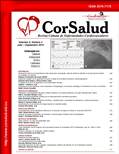Factores de riesgo en pacientes con síndrome coronario agudo remitidos para coronariografía
Resumen
Introducción: Los factores de riesgo coronario son características biológicas que aumentan la probabilidad de padecer una enfermedad cardiovascular.
Objetivo: Caracterizar la presencia de algunos factores de riesgo modificables en pacientes remitidos desde Pinar del Río al Hospital CIMEQ para coronariografía, en el contexto del síndrome coronario agudo.
Método: Estudio retrospectivo con los pacientes atendidos en el Laboratorio de Hemodinámica del CIMEQ, entre octubre de 1997 y agosto del 2008. La población de estudio estuvo constituida por los 5.297 pacientes a los que se les realizó coronariografía en el período señalado, de los cuales se analizaron los 147 remitidos de urgencia desde la provincia Pinar del Río, con el diagnóstico de síndrome coronario agudo, con y sin elevación del segmento ST. Los datos se obtuvieron de la base de datos ANGYCOR.
Resultados: El factor de riesgo más prevalente en los 126 pacientes con dicho síndrome, sin elevación del ST (85,7%), fue la hipertensión arterial (64 %); y el hábito de fumar (61,9 %) en aquellos con elevación del ST. Los pacientes entre 50 y 70 años (66,7 %) y los del sexo masculino (75,5 %) fueron los más afectados.
Conclusiones: Predominó el sexo masculino y el grupo de edades de 50-70 años en ambos grupos. Nueve de cada diez pacientes tienen al menos dos de los factores de riesgo clásicos, y el hábito de fumar y la hipertensión arterial fueron los más frecuentes.
Descargas
Citas
1. Ministerio de Salud Pública. Anuario estadístico de salud 2010. Cuba: MINSAP; 2011.
2. Martínez MA, González CJ. Rol de la angioplastia primaria en la actualidad. Boletín educativo SOLACI. 2008;4(6):3-7.
3. Aroche Aportela R, Obregón Santos AG, Alfonso Garriga M, Padrón KM. Aterosclerosis coronaria en pacientes tratados con intervencionismo percutá-neo [Internet]. 2006 [citado 7 Jul 2008]. Disponible en: http://www.sld.cu/galerias/pdf/sitios/urgencia/113_-_ateroesclerosis_coronariaen_pacientes_tratados_con_intervencionismo_percutaneo.pdf
4. González Fajardo I, Rojas Álvarez E, Moreno Martín G, Vargas González O, Cabrera Cabrera JR. Compor-tamiento de la letalidad por IMA en la unidad de cuidados coronarios del H.A.S. en el año 2004. Revista Universidad Médica Pinareña [Internet]. 2005 [citado 4 Feb 2012];1(1):[aprox. 4 p.]. Dis-ponible en: http://publicaciones.pri.sld.cu/rev-estud/rev-estud91/rev-estud911.html
5. Al-Huthi MA, Raja'a YA, Al-Noami M, Abdul AR. Prevalence of coronary risk factors, clinical pre-sentation, and complications in acute coronary syndrome patients living at high vs low altitudes in Yemen. Med Gen Med 2006;8(4):28.
6. Ortega-Gil J, Pérez-Cardona JM. Unstable angina and non ST elevation acute coronary syndromes. P R Health Sci J. 2008;27(4):395-401.
7. Wijpkema JS, Tio RA, Zijlstra F. Quantification of coronary lesions by 64-slice computed tomography compared with quantitative coronary angiography and intravascular ultrasound. J Am Coll Cardiol. 2006;47(4):891.
8. Spinler SA. Managing acute coronary syndrome: evidence-based approaches. Am J Health Syst Pharm. 2007;64(11 Suppl 7):S14-24.
9. Graham I, Atara D, Borch-Johnsenb K, Boysend G, Burell G, Cifkova R, Dallongeville J, et al. Guías de práctica clínica sobre prevención de la enfermedad cardiovascular: Versión resumida. Rev Esp Cardiol. 2008;61(1): 82.e1-82.e49.
10.Debs G, de La Noval R, Dueñas A, González JC. Prevalencia de factores de riesgo coronario en “10 de Octubre”. Su evolución a los 5 años. Rev Cubana Cardiol Cir Cardiovas. 2001;15(1):15-20.
11.Masia R, Pena A, Marrugat J, Sala J, Vila J, Pavesi M, et al. High prevalence of cardiovascular risk factors in Gerona, Spain, a province with low myocardial infarction incidence. REGICOR Investigators. J Epi-demiol Community Health. 1998;52:707-15.
12.Menotti A, Lanti M, Puddu PE, Kromhout D. Co-ronary heart disease incidence in northern and southern European populations: a reanalysis of the seven countries study for a European coronary risk chart. Heart. 2008;84(3):238-44.
13.Artaud-Wild SM, Connor SL, Sexton G, Connor WE. Differences in coronary mortality can be explained by differences in cholesterol and saturated fat intakes in 40 countries but not in France and Fin-land. A paradox. Circulation. 1993;88(6):2771-9.
14.Marrugat J, Solanas P, D'Agostino R, Sullivan L, Ordovás J, Cordón F, et al. Estimación del riesgo coronario en España mediante la ecuación de Fra-mingham calibrada. Rev Esp Cardiol. 2003;56(3): 253-61.
15.Laguna F, Vicente I, Mostaza Prieto JM, Lahoz Rallo C, Taboada M, Echániz A, García Iglesias F, et al. La aplicación de las tablas del SCORE a varones de edad avanzada triplica el número de sujetos clasifi-cados de alto riesgo en comparación con la función de Framingham. Med Clin (Barc). 2005;124(13): 487-90.
16.Pyorala K. Assessment of coronary heart disease risk in populations with different levels of risk. Eur Heart J. 2000;21:348-50.
17.Barrios V, Gómez-Huelgas R, Rodríguez R. Pablos-Velasco P. Adiponectina, un factor de riesgo cardio-vascular emergente. Estudio REFERENCE. Rev Esp Cardiol. 2008;61(11):1159-67.
18.Organización Mundial de la Salud y la Sociedad Internacional de Hipertensión. Prevención de las enfermedades cardiovasculares. Guía de bolsillo para la estimación y el manejo del riesgo cardiovas-cular [Internet]. Ginebra: OMS; 2008 [citado 6 Feb 2009]. Disponible en:
http://www.who.int/publications/list/cadio_pocket_guidelines/es/index.html
Descargas
Publicado
Cómo citar
Número
Sección
Licencia
Aquellos autores/as que tengan publicaciones con esta revista, aceptan los términos siguientes:- Los autores/as conservarán sus derechos de autor y garantizarán a la revista el derecho de primera publicación de su obra, el cuál estará simultáneamente sujeto a la Licencia de reconocimiento de Creative Commons que permite a terceros compartir la obra siempre que se indique su autor y su primera publicación esta revista.
- Los autores/as podrán adoptar otros acuerdos de licencia no exclusiva de distribución de la versión de la obra publicada (p. ej.: depositarla en un archivo telemático institucional o publicarla en un volumen monográfico) siempre que se indique la publicación inicial en esta revista.










